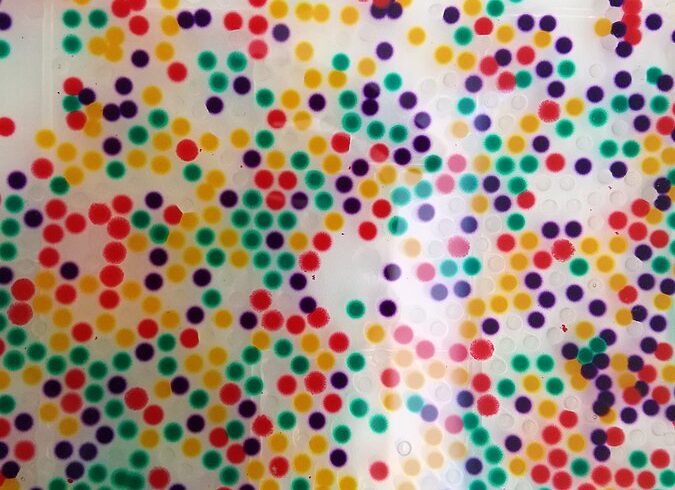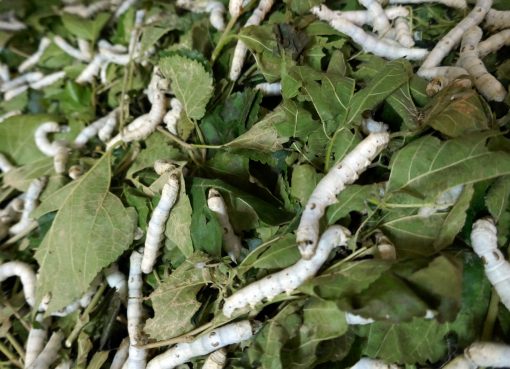Ruprekha Buragohain
M.Sc Scholar, Department of Horticulture, Assam Agricultural University, Jorhat
Email- ruprekha.buragohain.amj22@aau.ac.in
ABSTRACT
Depletion of water resources with time and also the unavailability of adequate water in arid and semi arid regions possess a major problem for cultivation of crops under such harsh conditions. Immense advancements have been made in the field of agriculture in the recent times to come up with solutions that are hampering cultivation and production of good quality crops and one of such modern day technology is HYDROGEL. It is one of the modern agricultural approach of water management under water-stressed conditions to conserve soil moisture in the active rooting zone of crops by reducing the evaporation, deep percolation, and runoff losses. Agricultural hydrogels are water retention granules which swell their original size to numerous intervals when they come in contact with water. It can absorb and retain a huge amount of moisture under plentiful rainfall and irrigation and release it back to the soil for meeting crop water demand when the rhizosphere zone dries up under drought conditions. It plays several beneficial roles in agriculture including soil-water retainer, nutrient and pesticide carriers, seed coating, soil erosion reducer, and food additives. These are biodegradable materials, nontoxic to the soil, crop, and environment and simultaneously decrease irrigation frequency, enhance the water and nutrient use efficiencies, and increase the yield. Hence, the addition of the hydrogel polymer will be a promising and feasible technological tool for augmenting crop productivity under moisture stressed conditions (Thakur et al., 2018; Li et al., 2020).
Keywords: Water shortage, Hydrogel, Modern approach, Biodegradable, Non-toxic
INTRODUCTION
The modern-day agriculture has been facing a series of problems in regards to cultivation of different crops due to the change in climatic conditions and the living style of human beings which directly or indirectly is affecting the conventional cultivation practices leading to the demand for development of new technologies and alternatives to develop a sustainable agricultural system for our country. The 21st century has been witnessing a decline in irrigation water potential inclined with the growing population around the globe and enhanced economic activities especially in arid and semi arid regions of India as well as the world. The problem of water crisis in such regions arises due to uncertain and inadequate natural precipitation.
As per the Central Water Commission, the demand for water is growing at a steady rate but the availability of clean water in future is declining even faster. In the Indian scenario, agricultural irrigation practices seem to be responsible for consumption of 80% of the available potable water. There is an increasing trend to this with the further intensification of agro-based industries. Due to the large geographical dimensions of the sub-continent and varied soil and farming practices, modern irrigation practices can still only cater to 40% of the grown crops. The remaining areas are far more susceptible to improper practices thus greatly lowering the effective and judicious use of available water for crops.
As a solution of such water related problems, modern day technology such as ‘Hydrogel’ is coming up. Hydrogel is a ‘water retention granule or polymer ‘having a three-dimensional network of loosely bound cross-linked versatile hydrophilic macromolecules interconnected by covalent bonds or physical interactions with specially designed absorbency and biodegradability. These materials desorb the stored moisture to the surrounding soil and rhizosphere zones during the soil drying process in a uniform manner over an extended period (Sayyari et al., 2012; Gaikwad et al., 2017). The capacity of the hydrogel in capturing and storing moisture arises from the hydrophilic functional groups attached to the polymer backbone and also from their resistance to dissolution arising due to the presence of cross-links between network chains (Kalhapure et al., 2016). Hydrogels are white sugar-like hygroscopic crystalline granules or tiny beads that swell manifolds in water or aqueous solution to form a clear gel made of separate individual particles.
IDEAL CHARACTERISTICS OF A HYDROGEL
- High water absorption capability
- Desired rate of absorption and desorption capacity according to plant requirement
- Lowest soluble content and residual monomer
- High durability and stability during swelling and storage
- High biodegradability and biocompatibility
- High performance over a wide temperature range
- After swelling, water becomes neutral in pH
- Colourless, odorless, and nontoxic
- Upscale the soil’s physical, chemical, and biological properties
- Photostability, rewetting capability for a longer time, low-cost material, and eco-friendly
WATER RETENTION AND RELEASE BEHAVIOR OF A HYDROGEL
- The hydrophilic groups present in hydrogel polymer includes acrylamide, acrylic acid, acrylate, carboxylic acid, etc., which are solely responsible for the water absorption property of a hydrogel.
- When the polymers come in contact with water, water penetrates the hydrogel system by osmosis, and hydrogen atoms react and come out as positive ions. This process leaves several negative ions along the length of the hydrogel polymer chain.
- These negative charges repel each other and ultimately force the polymer chain to unwind and open up and attract water molecules present in the surrounding soil particles and bind them with hydrogen bonding (Kalhapure et al., 2016).
- The hydrogel can absorb more than 400-1500 times their dry weight of water in this process and act as a miniature water reservoir. When the surrounding area around the root zone begins to dry up, the hydrogel gradually dispenses up to 95% of its stored water to plant absorption (Johnson et al., 1985; Peterson, 2002).
- When the surrounding area around the root zone begins to dry up, the hydrogel gradually dispenses up to 95% of its stored water to plant absorption.
- Under exposition to rewetting condition, rehydration starts and the process of storing water continues
- This polymer has the ability to increase water retention in soil which facilitates higher water uptake and water use efficiency, thus helping in reducing the water stress of plants and increasing crop growth and yield.
CLASSIFICATION OF HYFROGEL
Based on the source, hydrogel polymers used for agricultural purpose are classified into three types: (i) natural hydrogel, (ii) semiartificial hydrogel, and (iii) artificial hydrogel (Mikkelsen, 1999). The petroleum-based synthetic or artificial hydrogels that are mostly available in the market are categorized into three broad types based on their chemical composition and configuration as follows:
- Starch-polyacrylonitrile graft polymers (starch copolymers)
- Vinyl alcohol-acrylic acid copolymers (polyvinyl alcohols)
- Acrylamide sodium acrylate copolymers (cross-linked polyacrylamides)
USE OF HYDROGEL IN MODERN AGRCIULTURE
- Use as soil amendments – For the improvement of soil properties, the application of suitable soil conditioners increases for a common solution (Bhardwaj et al., 2007). The application of hydrogel (absorbent polymers) in agriculture is crucial because it can soak up water and make it available to plants over the long run (Akhter et al., 2012). Now-a-days, hydrogel polymers are being applied as soil additives in agriculture to reduce water loss and nutrient conservation in soil and ameliorate the negative effects of dehydration and moisture stress on crops (Gokavi et al., 2018). In particular, the use of hydrogel polymers in soils has several advantages, such as (i) it can absorb hundreds of times more water than its own weight and can act like a long-lasting gel (Thombare et al., 2018), (ii) it can protect the soil from runoff flow, (iii) it is effective in improving soil fertilizer performance and (iv) finally, it can improve the microbial activity in the soil (Gokavi et al., 2018). The biological effects of polyglutamic acid, an innovative hydrogel polymer component for the growth of corn and the improvement effects of beneficial soil microorganisms (Yin et al., 2018). The use of this organic polymer has proved that it can enhance soil conservation water, increase corn seedlings, and increase the population of plant growth-promoting microbial bacteria, such as Bacillus, Pseudomonas, and Burcholderia (Yang et al., 2020). Control seepage by the formation of membranes in soil that regulate the movement of water and nutrients downwards, increase soil permeability and infiltration, improve aeration, and soil drainage, and prevent salt toxicity injury to plants.
- Reduction in Drought stress – Drought stress in the soil due to shortage of water leads to production of oxygen radicals that result in increased lipid peroxidation and oxidative stress in the plants. As a result, drought stress produces some detrimental effects on plant morphology, such as loss of plant height, reduction of leaf area, and ultimately leaf damage. Therefore, the application of hydrogels can serve as saving tools for higher plant growth and crop yield even in adverse climatic conditions (Taylor et al., 1986). Several researchers have reported the profits of hydrogel in horticulture; in addition, it may increase the water-holding capacity of the soil (Bearce et al., 1997) and increase the water storage capacity of porous soils, reducing the chances of wilting for plants (Taylor et al., 1986). Addition of hydrogel at the time of planting is regarded to be an effective way for tree species in this region to combat high temperature and moisture stress conditions (Tomaskova et al., 2020).
- Increased fertilizer availability– The fertilizers that remain in the polymer network of hydrogel do not wash off immediately but are slowly released into the soil and then absorbed by the plants. The combined effects of hydrogels were studied with different types of fertilizers based on the traditional herbaceous NPK, super phosphate, and potassium chloride and observed on Mimosa scabrellaseedlings that their growth was increased because of higher water retention and nutrient uptake (Konzen et al., 2017).
4. Hydrogel as a Potting Medium – A light-weight potting medium is of more significant interest for growing plants especially under soilless culture systems due to its ease of handling. Therefore, hydrogel is considered to be a light-weight growing medium which can used in modern times for growing crops. The most significant requirement for a potting medium is excellent water-holding features to provide water and nutrients for plant development. Hydrogel was introduced as a potting medium in urban farming in the 1950s and has been used as a seed additive, to improve root establishment of seedlings, and in slow-release coatings (Abobatta, 2018). A poly-acrylamide-co-acrylic acid/silver-coated superabsorbent hydrogel nanocomposite demonstrated excellent water-retention capacity, which could be valuable in rainfed agriculture (Vundavalli et al., 2015). This aligns with the analysis of melon seedling growth which was found to be improved due to superabsorbent hydrogel composite contribution (Vasconcelos et al., 2020).
5. Alternative to Soilless Agriculture – Soilless agriculture is a method of planting crops in a medium other than soil, such as sand, peat, rock wool, sawdust, cocopeat, compost, perlite, vermiculite etc. Hydrogel is also considered a soil conditioner, due to its effects on soil structur, ability to infiltrate water, minimizing soil erosion and water run-off, decreasing soil compaction, supporting plant growth performance when less irrigated, and delaying dissolution of fertilizers to enable nutrient retention (Abobatta et al., 2018; Vasconcelos et al., 2020). Various types of hydrogels could be made to be utilized in soilless agriculture (Gholamhoseini et al., 2018). In soilless vertical farming based on woven, knit, and non-woven structures, integration of hydrogel in the cultivation beds to grow plants was found to be successful (Salam et al., 2019). Smart hydrogels embodied with silica-based nanoparticles serve as agrochemical carriers in plants. Additive manufacturing by fabricating hydrogels as receptive structures is suggested for soilless cultivation substrates that would promote plant growth (Kalossaka et al., 2021).
- Efficient Irrigation – The water-holding capacity of hydrogel enables water availability for long periods in the soil and the application of hydrogel as a soil amendment can reduce irrigation frequencies (Neethu et al., 2018). The use of hydrogel in sandy soils has been proven to retain water, thereby decreasing the need to irrigate (Tm et al., 2020). The application of 0.4% hydrogel as a soil amendment improved the water usage efficiency in growing Agrostis stolonifera(Agaba et al., 2011). Hydrogel is highly advocated for growing vegetable crops in agriculture on sandy soils, as shown in hydrogel-treated alluvial and red sandy loam soils. Water becomes available to plants for more than 1.5 – 2 times longer compared to non-treated soils (Narjary et al., 2012).
- In cold regions, the use of hydrogels does not freeze the moisture absorbed in the structure and makes easy accessibility to the plants, thereby regulating seedling growth temperature and preventing death by freezing.
METHODS OF HYDROGEL APPLICATION
There are mainly two methods for applying hydrogels in soils:
- Dry method to subsoil: Dry hydrogel polymer such as polyallylamine (PAAm) or polyvinyl alcohol (PVA) is applied to the subsoil by mixing with sandy soil at 15-25 cm depth, thus moistening the soil for swelling before cultivation. After the polymer has swollen, the soil structure is improved, and water penetration and retention capacity are increased.
- Wet method to topsoil: In this method, the polymer solution is sprayed onto initially wetted topsoil, followed by drying for water-stable aggregate stability and immediate sowing. This wet method can reduce water consumption, decrease soil erosion, and increase soil hydraulic conductivity. In the spray technique, the hydrogel can also be mixed with micronutrients and pesticides.
CONCLUSION
Water is becoming the most limiting factor for sustainable agricultural production in arid and semiarid regions. The application of hydrogel as a soil conditioner can improve the hydrophysical, physicochemical, and biological environments of the soil; increase the soil water retention and release capacity; improve irrigation, water, and nutrient use efficiencies; enhance the yield and quality of agricultural produce; and sustain the environmental quality. The hydrogel technology may become a practically convenient and radical technology in water-stressed areas in terms of increased yield and in alleviating soil moisture stress. This review focuses on the beneficial application of hydrogel on a large scale for improving modern agriculture which could be a way for the farmers and other agriculturists for optimization of water resource management for higher yield in agriculture. Hydrogels may aid agriculture, but they also come with constraints especially in terms of sustainability, cost, and application. Currently, the outcome of plants grown in the presence of hydrogel needs more research strategy in a multidisciplinary approach evolving modern farming systems for harnessing the benefits of developing technology such as hydrogel. By understanding the challenges, we must be able to address and come up with all the possible solutions and hypothesis regarding the suitable applicability of hydrogel for improving agricultural productivity as a whole.
REFERENCES
Neethu, T.M.; Dubey, P.K. and Kaswala, A.R. (2018). Prospects and Applications of Hydrogel Technology in Agriculture. Int. J. Curr. Microbiol. Appl. Sci. 7: 3155–3162. doi: 10.20546/ijcmas.2018.705.369.
Tm, S.; Thakur, N. and Sharma, P. (2020). Use of Alternative Growing Media in Ornamental Plants. Int. J. Chem. Stud. 8:188–194. doi: 10.22271/chemi.2020.v8.i6c.11079.
Agaba, H.; Orikiriza, L.J.B.; Obua, J.; Kabasa, J.D.; Worbes, M. and Hüttermann A. (2011). Hydrogel Amendment to Sandy Soil Reduces Irrigation Frequency and Improves the Biomass of Agrostis Stolonifera. Agric. Sci. 02:544–550. doi: 10.4236/as.2011.24071.
Narjary, B.; Aggarwal, P.; Singh, A.; Chakraborty, D. and Singh, R. (2012). Water Availability in Different Soils in Relation to Hydrogel Application. Geoderma. 187–188: 94–101. doi: 10.1016/j.geoderma.2012.03.002.
Konzen, E.R.; Navroski, M.C.; Friederichs, G.; Ferrari, L.H.; Pereira, M. D. O. and Felippe, D. (2017). The use of hydrogel combined with appropriate substrate and fertilizer improve quality and growth performance of Mimosa scabrella benth. Seedlings. Cerne, 23 (4): 473–482.
Abobatta, W. (2018). Impact of Hydrogel Polymer in Agricultural Sector. Adv. Agric. Environ. Sci. Open Access. 1: 59–64.
Tomášková, I; Svatoš, M.; Macků, J. et al. (2020). Effect of different soil treatments with hydrogel on the performance of drought-sensitive and tolerant tree species in a semi-arid region. Forests, 11 (2): 211.
Bearce, B.C. and Mccollum, R.W. (1997). A comparison of peat-like and non-composted hardwood-bark mixes for use in pot and bedding-plant production and the effects of a new hydrogel soil amendment on their performance. Florists’ Review, 161:21–66.
Taylor, K.C. and Halfacre, R.G. (1986). Hydrophilic polymer effect on nutrient and water availability to Ligustrum ludicum ‘compactum’ grown in pine bark medium. Horticultural Science, 18: 1159–1161.
Yin, A; Jia, Y.; Qiu, T. et al. (2018). Poly-γ-glutamic acid improves the drought resistance of maize seedlings by adjusting the soil moisture and microbial community structure. Applied Soil Ecology, 129: 128–135.
Thombare, N.; Mishra, S.; Siddiqui, M.; Jha, U.; Singh, D. and Mahajan, G.R. (2018). Design and development of guar gum based novel, superabsorbent and moisture retaining hydrogels for agricultural applications. Carbohydrate Polymers, 185: 169–178.
Peterson, D. (2002). Hydrophilic polymers – effects and uses in the landscape. Restoration and Reclamation Review, 75: 16.
Ahmed, S.S. and Fahmy, A.H. (2019). Applications of natural polysaccharide polymers to overcome water scarcity on the yield and quality of tomato fruits. Journal of Soil Sciences and Agricultural Engineering, 10 (4): 199–208.
Palanivelu, S.D.; Armir, N.A.Z.; Zulkifli, A. et al. (2022). Hydrogel Application in Urban Farming: Potentials and Limitations—A Review. Polymers (Basel). 14(13): 2590. https://www.ncbi.nlm.nih.gov/pmc/articles/PMC9268874/
Anon. (2020). Hydrogel Agriculture. https://vikaspedia.in/agriculture/best-practices/sustainable-agriculture/crop-management/hydrogel-agriculture-technologyNarjary, B.; Aggarwal, P.; Kumar, S. and Meena, M.D. (2013). Significance of hydrogel and its application in agriculture. Indian Farming. 62 (10): 15-17. https://krishi.icar.gov.in/jspui/bitstream/123456789/24065/1/indian%20farming.pdf Patra, S.K.; Poddar, R.; Brestic, M.; Acharjee, P.U.; Bhattacharya, P.; Sengupta, S.; Pal, P.; Bam, N.; Biswas, B.; Barek, V.; Ondrisik, P.; Skalicky, M. and Hossain, A. (2022). Prospects of Hydrogels in Agriculture for Enhancing Crop and Water Productivity under Water Deficit Condition. International Journal of Polymer Science, Article ID 4914836. https://doi.org/10.1155/2022/4914836 https://www.hindawi.com/journals/ijps/2022/4914836/




